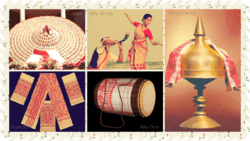Assamese Brahmins
| Regions with significant populations | |
|---|---|
| India | Assam |
| Languages | |
| (and dialects; Kamrupi • Goalpariya) | |
| Religion | |
| Hinduism | |
| Part of a series on the |
| Culture of Assam |
|---|
 |
|
Protohistoric
Ancient Medieval Colonial |
|
|
|
|
Festivals
|
| Religion |
|
History
Archives
Genres
Institutions Awards Asam Sahitya Sabha Award • Kamal Kumari Foundation Award • Krishnakanta Handique Award |
|
Music and performing arts |
|
Assamese Brahmins are the Brahmins present in Assamese society, being one of the four traditional Hindu social divisions along with the Kshatriyas, Vaisyas, and Sudras. There are two classes in Assam, of which the Ganaks, who are also known as Daivajna, are one. That group follows the Atharva Veda (the solar cult).[1]
There they promoted learning, Vedic religion and astrology, besides imparting general vedic knowledge to the public.[2] Their origin was probably the Gangetic Plain: according to the Nidhanpur copper plate, around 200 Brahmin families of various gotras and ved–sakhas moved from there to Assam on the invitation of Bhutivarman in the 6th century CE.[3] Some Assamese Brahmin surnames are : Sarma,Thakur,Borthakur, Bordoloi, Borpuzari, Bhagawati,Buzarbaruah, Barua, Baruah, Bezbaruah, Sabhapandit.
History
Historically, Brahmins in Assam were organised under specific gotras, indicating their Lineage (or their descent from different Rishis and the rules regarding such matters as inheritance, marriage, worship, and sacrifices. They are considered to be one of the oldest Hindu settlers in the region and held the highest positions in society.[4][5]
Assamese Brahmins are the community in that state who are considered to have Caucasoid origins.[6]
Tradition and culture
Lagundeoni
Traditionally, the ceremony of Lagundeoni – one of the Sanskaras or rites of passage marking acceptance of a student by a Guru, is a quite prevalent ritual within the community.[7] A sacred thread – Lagun, given by a Pujari during the ceremony is a symbolic reminder to the young male born to the Brahmin family of his purpose at school, as well as a social marker of the student as someone who has embarked his journey into formal education, where education itself is not limited to ritual and philosophical speculations, but extends to all practical aspects of culture and life in general. The ceremony is typically performed between ages 12 – 14 among Brahmin males.
Death rituals
Brahmins of the valley follow a different death ritual as opposed to the other indigenous communities in Assam. A religious rite, known as Caturthā is performed on the 4th day of a person's demise unlike Tiloni, performed on the 3rd day of person's demise by non–Brahmin indigenous communities.[8]
Pujas
Most Brahmin families are involved in performing religious rituals,[9] known as Pujas.
Lifestyle
Although in general Brahmins observe all the customary rituals, they appear usually less rigid[10] in some of their traditional lifestyle choices, such as they may eat meat, fish, unlike their counterparts in North India.[11]
Present
The Brahmins constitute one of the Forward classes of Assam[12] based on the classifications of Government of India, although the recent trend on economic condition has not been very well within the community. Assam's former Chief Minister, Tarun Gogoi announced setting up of development councils for several communities in the state, including Brahmins.[13]
References
- ↑ Barua, Preeti (2000). Nalinibala Devi. pp. 1–3.
- ↑ Dikshit, K. R.; Dikshit, Jutta K. (2013). North-East India: Land, People and Economy. Springer Science & Business Media. p. 397.
- ↑ Dikshit, K. R.; Dikshit, Jutta K. (2013). North-East India: Land, People and Economy. Springer Science & Business Media. p. 390.
- ↑ Social History of Assam: Being a Study of the Origins of Ethnic Identity and Social Tension During the British Period, 1905-1947 – Pre–British History and Society. Manilal Bose, Concept Publishing Company. 1989.
- ↑ "Culture – Social Life, Social Institutions, Women". Government of Assam.
- ↑ Socio-economic profile of Rural India (series II) – Roots, page 15. S.C. Patra and Ashish Vachhani, Concept Publishing Company, 2011.
- ↑ "Assam State Gazetteer Vol. 1, page 317 – Government of Assam". Mr. Amlan Baruah and S.B. Roy Choudhury. 1999.
- ↑ Among the Luminaries in Assam: A Study of Assamese Biography, page 54. Anjali Sarma, Mittal Publications. 1990.
- ↑ "Religion and Caste". Assam On–line Portal, Government of Assam.
- ↑ Social History of Assam: Being a Study of the Origins of Ethnic Identity and Social Tension During the British Period, 1905–1947, Pre–British Assamese Society, page 44. Manilal Bose, Concept Publishing Company. 1989.
- ↑ "Assam Government Withdraws Meat Sale Ban at Cultural Festival After Social Media Outcry, The Wire". The Wire Staff. 30 March 2017. Retrieved 6 September 2017.
- ↑ "Sabha lists NRC demands – Assam literary body seeks changes in legacy data provision, The Telegraph (Calcutta – Gauhati)". Staff reporter. 11 August 2015. Retrieved 6 September 2017.
- ↑ "Gogoi announces development councils for Brahmins, others, India Today". PTI – Press Trust of India. 1 January 2016. Retrieved 5 September 2017.